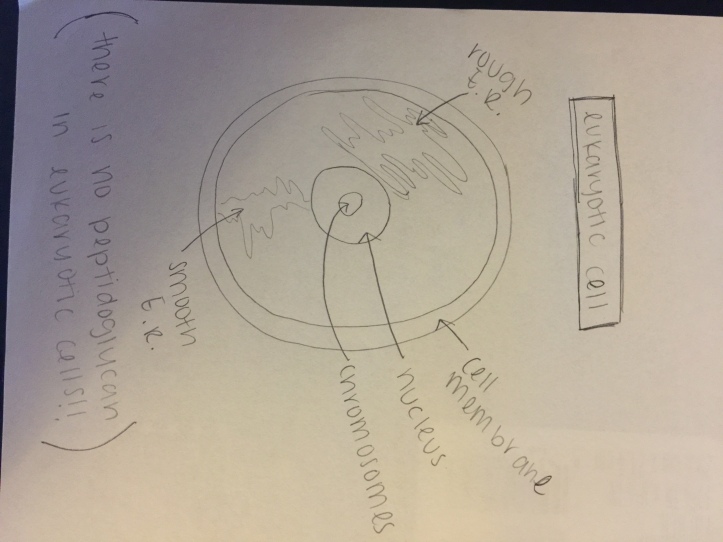- Drawing of an average enveloped virus:
Drawing of an average bacteria cell, gram-positive and gram-negative: 
Drawing of an average eukaryotic cell:

2. Bacteria:
Bacteria is the largest out of the three types of organisms: Bacteria, Eukaryotes, and Viruses. Bacteria is obviously not huge, but it can grow and get larger and larger. Bacteria can appear in either a coccus, bacillus, or spiral shape. The structure of a bacterial cell includes: Chromosomes, ribosomes, plasmid, cell membrane, peptidoglycan, and the outer membrane. There’s either gram-positive or gram-negative bacteria. One big difference between the two is that gram-negative bacteria has an outer membrane and gram-positive does not. All of their other structures are the same. You can find flagella outside of this organism.
Eukaryotes:
Eukaryotes are smaller than bacteria, but bigger than viruses. The structure of a eukaryote includes: Cilia, flagella, plasma membrane, cytoplasm, chromosomes, nucleus, ribosomes, mitochondria, golgi apparatus, endoplasmic reticulum (rough and smooth), lysosomes, and glycocalyx. The cell wall does a good job of separating the inside of the organism from the outside environment. Not all eukaryotic cells have these same structures, though. For example, plant cells have a cell wall, but animal cells do not. There are no structures that are outside of the organism.
Viruses:
Viruses are the smallest of the three organisms. In fact, bacteria can be up to 100 times larger than viruses. The structures inside of this organism include the genome and the capsid. The envelope and viral spikes keep the inside of the viruses separated from the outside environment.
Enveloped viruses and non-enveloped viruses both include spikes, capsids, and genomes (nucleic acids). The non-enveloped virus obviously doesn’t have an envelope and the enveloped virus does. There are no structures that are outside of the organism.
3. It is important to understand the similarities and differences between these kinds of organisms, in terms of pathogenic organisms, for many reasons. A pathogenic organism can cause disease in it’s host. It is helpful to know this information, especially if you’ve been infected with some type of sickness or disease; You will need to be able to recognize if it is a bacteria or a virus. Knowing this will help you to further find information on how to cure the sickness and get back to health. It’s also important to know where we came from. For example, life began as one tiny cell that multiplied and multiplied and so on, which eventually became what we call our lives now. So, it is nice to know how we all started and came about. It’s a good idea to know how to determine which organisms you’re dealing with so that you can know how to handle it.

